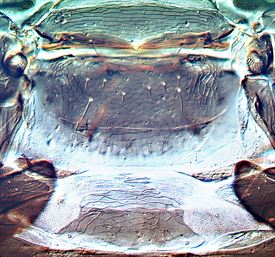Distinguishing features
Female fully winged or micropterous. Body dark brown, tarsi paler; base of antennal segment III yellow; fore wings shaded, darker distally; major setae pale. Head slightly constricted behind eyes and at base; compound eyes as large dorsally as ventrally; postocular setae acute; 1 pair of slightly larger setae medially on vertex; maxillary stylets retracted to postocular setae. Antennal segments elongate, each with a distinct pedicel. Pronotal major setae blunt, midlaterals and epimerals longest; basantra absent. Mesonotal lateral setae not elongate; mesopresternum transverse. Metanotum with striate lines of sculpture laterally, reticulate to faintly reticulate medially; 1 pair of median acute setae and up to 5 pairs of shorter, stout setae anterior to these; metathoracic sternopleural sutures short. Fore tarsal tooth present. Fore wings with 12–15 duplicated cilia; major sub-basal setae acute, S3 usually the longest, S1 often missing. Pelta rounded, without lateral lobes, reticulate, recessed into concave anterior margin of tergite II; tergites II–VII each with 2 pairs of sigmoid wing-retaining setae; tergite IX posteromarginal setae S1 acute, about half as long as tube. Female microptera with eyes smaller ventrally than dorsally; mesonotum and metanotum transverse; fore wing lobe bearing 1 major seta; pelta usually more square; tergites II–VII each with 2 pairs of curved wing-retaining setae.
Male micropterous. Similar to female but head with a ventral tubercle anterior to major pair of interocular setae, stout cheek setae, and postocular setae longer, with spatulate apices; pronotum elongate, with major setae longer, spatulate; probasisternal plates longer than wide; fore tarsal tooth enlarged; fore femora swollen; tergite IX posteromarginal setae S1 shorter, blunt, S2 stout; sternite VIII with a transverse pore plate; sternites II–VII with striate to reticulate lines of sculpture laterally. Large males with tarsal tooth, femora and pronotum greatly enlarged, and major setae elongate.
Related species
The genus Hoplothrips comprises about 130 species worldwide, of which 7 are recorded from New Zealand. Several of these appear to be endemic to this country, but corticis is from the Northern Hemisphere and orientalis is probably from Asia. H. anobii is considered endemic, as the following character states are not known in Hoplothrips species from any other part of the world: metanotum with numerous stout setae; large males with a stout, horn-like tubercle on head ventrally, in front of interocular setae; antennal segment III elongate and dark, with only base of pedicel yellow. A horn-like tubercle is also sometimes present in large males of H. orientalis, but it arises in a different position, and these two species are probably not closely related.
Biological data
This species has been collected at two localities in beetle galleries (Anobium species) on dead branches.
Distribution data
Known only from New Zealand (NC, CO).
Family name
PHLAEOTHRIPIDAE, PHLAEOTHRIPINAE
Species name
Hoplothrips anobii Mound & Walker
Original name and synonyms
Hoplothrips anobii Mound & Walker, 1986: 59
References
Mound LA & Walker AK (1986) Tubulifera (Insecta: Thysanoptera). Fauna of New Zealand 10: 1–140.


